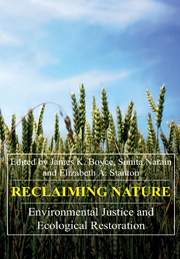Book contents
- Frontmatter
- Contents
- List of Figures and Tables
- Acknowledgements
- Introduction
- Part I ADDING VALUE
- Part II DEMOCRATIZING ACCESS
- 5 Land Reform and Sustainable Development
- 6 Extractive Reserves: Building Natural Assets in the Brazilian Amazon
- 7 Mining Rights and Community Rights: Poverty amidst Wealth
- 8 Natural Assets and Participatory Forest Management in West Africa
- Part III CAPTURING BENEFITS
- Part IV DEFENDING THE COMMONS
- About the Contributors
- Index
8 - Natural Assets and Participatory Forest Management in West Africa
from Part II - DEMOCRATIZING ACCESS
Published online by Cambridge University Press: 05 March 2012
- Frontmatter
- Contents
- List of Figures and Tables
- Acknowledgements
- Introduction
- Part I ADDING VALUE
- Part II DEMOCRATIZING ACCESS
- 5 Land Reform and Sustainable Development
- 6 Extractive Reserves: Building Natural Assets in the Brazilian Amazon
- 7 Mining Rights and Community Rights: Poverty amidst Wealth
- 8 Natural Assets and Participatory Forest Management in West Africa
- Part III CAPTURING BENEFITS
- Part IV DEFENDING THE COMMONS
- About the Contributors
- Index
Summary
Introduction
Participatory forest management in West Africa became institutionalized during the 1980s as part of the movement towards decentralization under structural adjustment programmes. Most nation states in the region have implemented forest-sector administrative reforms that give greater roles to communities in forest management, and that recognize the importance of building partnerships between communities and forest departments (Brown 1999).
The idea that community participation is central to effective natural resource management has been endorsed in a number of international environmental conventions. It was given a prominent place in both the 1992 Rio Earth Summit and the 1994 UN Convention to Combat Desertification. It was embraced again in 1997, in the United Nations Intergovernmental Panel on Forests' Proposals for Action, which called for the establishment of participatory mechanisms to involve all interested parties, including local communities and indigenous people, in policy development as well as implementation.
Although most West African forestry services now have moved beyond previous exclusionary approaches, participatory forest management still generally is situated within a technocentric, top-down framework. The goal is to get rural communities to participate in the programmes designed by global and national agencies, rather than to enable rural people to make their own inputs into natural resource policy. The main concerns, rooted in neo-liberal economic philosophy, are the need to make forestry management more efficient and to lower transaction costs by involving communities.
- Type
- Chapter
- Information
- Reclaiming NatureEnvironmental Justice and Ecological Restoration, pp. 203 - 234Publisher: Anthem PressPrint publication year: 2007
- 1
- Cited by

